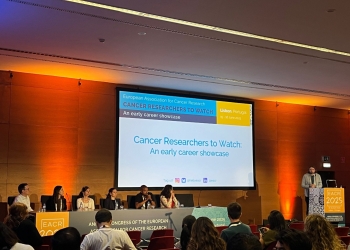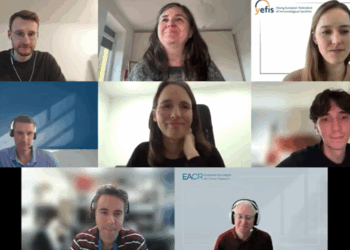The EACR’s ‘Highlights in Cancer Research’ is a regular summary of the most interesting and impactful recent papers in cancer research, curated by the Board of the European Association for Cancer Research (EACR).
The list below appears in no particular order, and the summary information has been provided by the authors unless otherwise indicated.
Use the dropdown menu or ‘Previous’ and ‘Next’ buttons to navigate the list.
Peinado, P., Stazi, M., Ballabio, C. et al. Nature. 639: 765–775. (2025).
doi: 10.1038/s41586-024-08575-7.
 Summary of the findings
Summary of the findings
Small-cell lung cancer (SCLC) is characterised by its high molecular heterogeneity. How this diversity contributes to its aggressiveness remains an open question. This study reveals that neuroendocrine (NE) cancer cells in SCLC not only resemble neurons in their transcriptomic profile, but also in their electrophysiological properties. These cells generate electrical signals, firing action potentials and propagating calcium waves, to promote tumour progression.
However, maintaining this electrical activity requires supplemental energy sources. NE cells exploit oxidative metabolism and rely on neighbouring non-NE cancer cells to supply lactate, much like neurons depend on astrocytes. This metabolic symbiosis fuels ATP production, which is required for the increased electrical activity in NE cells. Suppressing the electrical signals of NE cells, either indirectly by blocking lactate transport or directly by tetrodotoxin and chemogenetics, dramatically reduces tumour growth and metastasis both in vitro and in vivo.
Moreover, SCLC patients with higher levels of classic neuronal markers in their tumours had worse outcomes, suggesting that the electrical activity of cancer cells plays a key role in disease progression.
The discovery that electrical activity directly drives SCLC progression unveils a powerful vulnerability and opens electrifying new avenues for therapy by cutting these circuits and aiming to pull the plug on aggressive tumours.

Future impact
The discovery that the electrical activity of NE cells in SCLC has an impact on tumour progression opens novel therapeutic avenues to target this unique characteristic. Further research is needed to comprehend the biological mechanisms induced by the increased electrical activity, which could also lead to a better understanding of this aggressive disease. Moreover, this study also describes a metabolic interplay between the NE and non-NE cells, presenting an additional therapeutic strategy to target this interaction and hinder SCLC progression.









